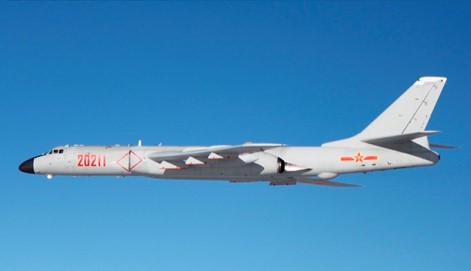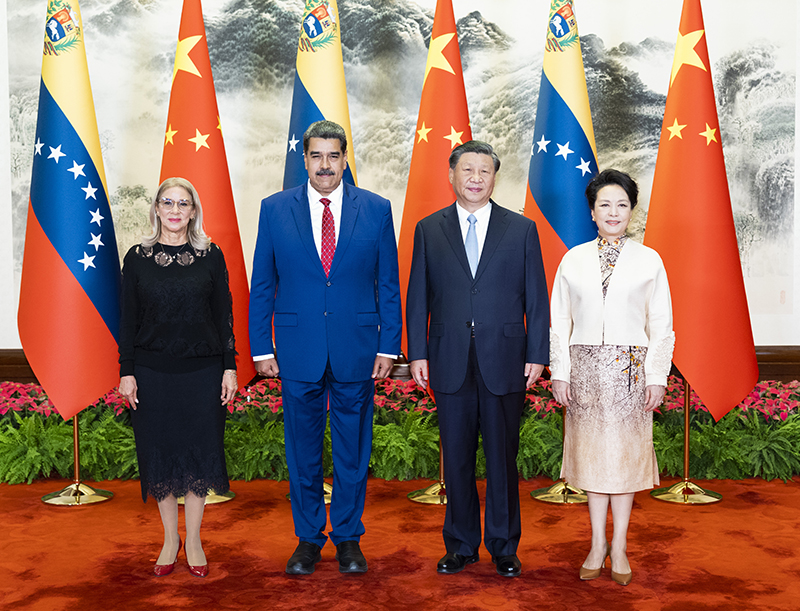
PLA Steps up Security Cooperation With Russia in 2024
PLA Steps up Security Cooperation With Russia in 2024
Executive Summary:
- This year’s second joint aerial patrol between the People’s Republic of China (PRC) and Russia marked the debut of the nuclear-capable H-6N bomber, demonstrating Beijing’s intent to project nuclear deterrence and challenge Western strategic dominance.
- The two countries have expanded security cooperation this year, including through joint maritime drills near Alaska and in the Arctic.
- A month-long joint patrol between the China Coast Guard and its Russian counterpart in the Arctic shows the expansive scope of Beijing’s defined maritime rights and interests and indicates its growing presence in the Arctic.
On November 29, the People’s Republic of China (PRC) and Russia conducted their ninth “Joint Strategic Air Patrol (联合空中战略巡航),” their second of 2024 (People’s Daily Online, November 30). During the operation, the PRC deployed its H-6N bomber, the first time the People’s Liberation Army (PLA) has introduced a bomber with nuclear capabilities into such patrols. The flight traversed the Sea of Japan and the East China Sea without entering Japanese or Republic of Korea’s airspace, though it still garnered attention from the United States and regional actors (Global Times, November 29; Reuters, November 30). This patrol was the first such military cooperation conducted following the US presidential election, though it was not necessarily unusual—the seventh joint strategic air patrol took place at a similar time in 2023 (MND, December 14, 2023).
The patrol is part of increasing Sino-Russian military cooperation, which seeks to increase deterrence against the United States and its allies, as well as seeking to more proactively assert the two countries’ rights and interests. Over the past few months, the two countries have coordinated in two maritime exercises, as well as joint maritime law enforcement activities in the Arctic Sea. This latter exercise indicates the PRC’s growing interest in using Russia to expand its presence in the Arctic.
Sino-Russian Patrol Ventures Into Seas Around Korea, Japan
Since 2019, the PRC and Russia have jointly conducted aerial patrols as part of their annual military cooperation plans. Each year, PLA and Russian military aircraft enter the Republic of Korea’s air defense identification zone once or twice under the guise of military exercises or strategic patrols. They have never provided prior notification of their operations (Yonhap News, November 29).
A total of 27 aircraft were involved in the two-day Sino-Russian joint strategic aerial patrols, according to a report from the Japanese Ministry of Defense’s Joint Staff. The report noted that two of the PLA’s H-6 bombers and two J-16 fighter jets flew from the East China Sea to the Sea of Japan on November 29. That same day, two H-6 bombers and two Russian Tu-95 bombers conducted long-range flights from the Sea of Japan to the East China Sea. During the patrol over the Sea of Japan, a Russian fighter jet joined the formation (NHK, November 30). Prior to the joint patrol, a PLA’s Y-9 electronic reconnaissance aircraft had already flown from the East China Sea to the Sea of Japan (Liberty Times, December 1). This means that a total of 10 Chinese and Russian aircraft, including bombers, conducted operations near Japan.
On November 29, five PLA and six Russian military aircraft entered and exited the Republic of Korea’s air defense identification zone without prior notice. None of these aircraft violated the country’s airspace, just as in the December 2023 iteration of the patrols (USNI News, December 14, 2023; UDN, November 29). During the operation, PRC military aircraft entered the air defense identification zone from the southwest near Socotra Rock (also known as leodo) and flew toward Dokdo (also known as the Liancourt Rocks), while Russian military aircraft approached Dokdo from the northeast. The two groups of aircraft converged over waters south of Dokdo, loitered in the airspace briefly, and then returned to their respective bases.
On November 30, the Japanese Ministry of Defense reported the presence of a total of 17 PLA and Russian bombers and fighter jets operating in airspace around Japan. These bombers were observed flying from the PRC, passing between Okinawa’s main island and Miyako Island, and heading toward the Pacific Ocean. During the operation, four PLA’s J-16 fighter jets, one additional PLA’s military aircraft, and one Y-20 aerial refueling aircraft joined the formation. Subsequently, the four bombers reversed course over the Pacific Ocean and flew back through the airspace between Okinawa and Miyako Island before heading to the East China Sea (CNA, December 1).
PLA Advances Strategic Deterrence Capabilities
On November 29, the PRC Ministry of National Defense released a brief statement regarding the joint strategic aerial patrol, stating that it was conducted “in accordance with the annual cooperation plan between the Chinese and Russian armed forces (根据中俄两军年度合作计划)” (MND, December 14, 2023). This annual joint patrol, a hallmark of bilateral military cooperation since 2019, is part of a broader annual cooperation framework.
Unlike in previous years, this year’s operation saw the participation of the H-6N strategic bomber—which is capable of carrying nuclear weapons—for the first time (Xinhua, November 29). Official media channels shared images and videos on social media, including X and Weibo. These posts highlight that this was the first time the H-6N was involved in such a combat patrol, though they do not explicitly mention its nuclear capabilities (Weibo/CCTV, November 29; X/@CCTV_Plus, November 30). The incorporation of these aircraft as part of the patrols underscores recent advances in the PLA’s military technology and capabilities.
According to state-owned media the Global Times, the joint strategic aerial patrol had two main aims. First, it was intended to strengthen mutual trust and cooperation between the two militaries. Second, it formed part of broader preparations for comprehensively addressing regional and global security challenges. The report cited PLA officials emphasizing the H-6N’s improved aerial refueling capability compared to that of the H-6K (an earlier model), enabling it to undertake longer-range missions and significantly expanding the strategic reach of the PLA Air Force (Global Times, November 29).
The joint patrol also extended the strategic messaging established during the eighth iteration of the exercise in late July, when Chinese and Russian bombers flew to within approximately 200 miles of Alaska’s coastline. These operations demonstrate Beijing’s intent to showcase its nuclear deterrence capabilities to the United States and other Western nations. This aligns with growing concerns within the US government regarding the PRC’s expanding nuclear arsenal and strategic ambitions (ICCS, September 4; DOD, December 18).
Sino-Russian Cooperation as Counterbalance to Western Powers
The intensification of Sino-Russian military cooperation reflects the two countries’ shared objective of counterbalancing Western powers, particularly the United States (CNA, September 19). Both nations face mounting pressure from the West. Russia has been subjected to severe sanctions and diplomatic isolation following its invasion of Ukraine, while Beijing increasingly has been embroiled in disputes with Washington over issues such as Taiwan and the South China Sea. This shared predicament has driven both countries to strengthen their strategic partnership and bolster military collaborations (CNA, May 24).
In recent months, the PRC and Russia have expanded security cooperation not only in joint military exercises but also in maritime law enforcement operations. Beginning with the first Sino-Russian bomber patrol over the Bering Sea in July 2024 and extending to subsequent operations in the Sea of Japan, the frequency and geographic range of this cooperation have steadily increased. This development highlights a growing level of mutual trust and interoperability.
The two nations have conducted two military exercises together this year, “North-Joint 2024 (北部·联合-2024)” and “Ocean-2024 (海洋2024)” (EDM, November 14, 18). These drills have raised concerns within the North Atlantic Treaty Organization (NATO) about potential security threats posed to Europe and the Indo-Pacific region by Sino-Russian activities and have emphasized the two nations’ capability to coordinate responses to perceived strategic challenges in both maritime and aerial domains, and their willingness to enhance that capability (RTI, September 9).
Beyond military coordination, the first-ever joint patrol conducted by the China Coast Guard (中国海警) and the Russian Federal Security Service took place in Arctic waters on October 2 (CCTV, October 2; EDM, October 8). This patrol marked a significant milestone in Sino-Russian maritime cooperation. The timing coincided with the PRC’s National Day celebrations and the 75th anniversary of diplomatic relations between the two nations on October 1. During the patrol, China Coast Guard vessels were tested in the harsh Arctic environment, demonstrating their resilience to extreme weather (Polar and Ocean Portal, October 10). The joint patrol was conducted within Russia’s exclusive economic zone and the Bering Sea near Alaska (World Journal, October 2).
Both nations are increasingly focused on the protection and development of infrastructure, trade, and other activities in the Arctic. As the region’s ice recedes due to global warming, the Northern Sea Route is becoming more viable, enhancing its strategic importance. The route offers a shorter maritime passage between Europe and Asia but also provides opportunities to exploit the region’s abundant natural resources. The two countries envision a jointly developed “Ice Silk Road,” with a ship named the “Arctic Express” making the inaugural journey this summer as part of the project from Arkhangelsk in Northern Russia to Shanghai (EDM, September 5).
Key details in PRC coverage of the activities illustrate the unusual extent of this operation for the China Coast Guard. These include noting that the China Coast Guard vessels traveled a total of 17,000 nautical miles up to the Arctic and back to defend “maritime rights and interests (海洋维权).” The Coast Guard vessels spent a month on the water, indicating that this was also an attempt to train endurance and resilience and test the Coast Guard’s capacity for protracted missions. It also underlines the increasingly expansive scope of Beijing’s definition of the extent of its interests far beyond its borders and waters. The two countries’ coast guards engaged in a number of maritime security-related activities during the operation, as well as taking part in sports and other cultural exchanges, which suggests a desire for long-term cooperation between the two organizations. Such actions are seen as setting a precedent for future bilateral maritime cooperation (Xinhua, October 18).
Conclusion
Recent exercises between the PRC and Russia involved both countries’ air forces, navies, and respective coast guards. This is evidence of the strength of the bilateral relationship and the desire from both sides for enhanced security cooperation.
The route taken in the joint aerial patrol in November indicates that the two countries continue to refuse to recognize the Republic of Korea’s air defense identification zone, while their deliberate traversing of key maritime corridors surrounding Japan is another element of persistent gray zone tactics used against these and other countries in the region. Taken together, these activities also demonstrate the strategic resolve of both countries to counterbalance perceived encirclement by Western allies in the region.
An escalation in collaborative military maneuvers poses tangible security threats not only regionally but also globally. An incoming Trump administration in the United States will affect the calculus of US allies in the region. How these players react, adjust, and adapt to growing PRC and Russian activities will influence the regional security landscape going forward.
The views expressed in this article are solely those of the author.


